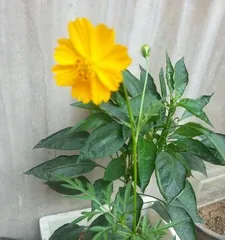Scorpion Lotus is a beautiful ornamental plant, but it is not easy to make it bloom. To make it bloom, you need to master the correct care methods. This article will detail how to make the Scorpion Lotus bloom from multiple aspects such as fertilizer selection, water control, and temperature requirements.

I. Understanding the Scorpion Lotus
Scorpion Lotus, also known as Dragon's Claw, is a perennial herb native to South America, Central America, and the Caribbean region. Its flower has a unique shape, like an open eagle's claw, and is mostly red or orange in color.
II. Fertilizer Selection
Scorpion Lotus prefers soil rich in organic matter, so when choosing fertilizer, you can select a compound fertilizer or organic fertilizer rich in organic matter. When fertilizing, spread it evenly on the surface of the potting soil and mix it lightly into the soil.

III. Water Control
Water is an important factor affecting the growth and flowering of Scorpion Lotus. Generally, water once a week, but be careful not to overwater. Check the soil moisture before watering; if the surface is dry, water it appropriately. At the same time, avoid waterlogging to affect plant growth.
IV. Temperature Requirements
Scorpion Lotus likes a warm environment and is suitable for growth between 18°C and 24°C. In summer high temperatures, it can be placed in a semi-shady place to avoid direct sunlight. In winter, it needs to be kept indoors and pay attention to insulation.
V. Light Control
Scorpion Lotus likes a well-lit environment, but avoid direct sunlight. It can be placed under a transparent glass cover or a shading net to control the intensity of light.

VI. Pest and Disease Control
Scorpion Lotus is susceptible to pests such as aphids and whiteflies, so timely measures must be taken for prevention and control. You can choose common household insecticides or manually remove pests.
VII. Pruning Methods
Proper pruning is beneficial for the growth and flowering of Scorpion Lotus. During the growing period, you can prune off dead leaves, branches, and flower buds to promote new growth. However, avoid excessive pruning to avoid affecting the plant's growth.
VIII. Suitable Potting Soil
Scorpion Lotus likes well-drained and fertile soil. You can choose a potting soil mixed with loose sand, leaf mold, and clay to ensure the ventilation and water retention of the potting soil.
IX. Regular Repotting
Scorpion Lotus needs to be repotted every spring to renew the soil and roots. When repotting, be careful to protect the roots and do not move the plant excessively to avoid affecting its growth.
X. Winter Care
Winter is the dormant period for Scorpion Lotus, so it must be kept in a low-temperature and low-humidity environment. At the same time, pay attention to reducing the frequency of watering to avoid the soil being too wet.
XI. Summer Care
In summer high temperatures, maintain appropriate humidity, increase the frequency of watering, and place the Scorpion Lotus in a semi-shady place. In addition, you can regularly spray water on the plant to increase humidity and cool it down.
XII. Pay Attention to Observation
When caring for Scorpion Lotus, pay attention to observing the plant's condition and discover and deal with problems in time. If you find that the plant's leaves are yellow or withered, it may be due to overwatering or lack of nutrients, and you need to adjust the care measures in time.
XIII. Be Patient
Scorpion Lotus takes a certain time to bloom, so patience is required. Generally, Scorpion Lotus will bloom after the growing period. If it does not bloom for a long time, you can appropriately adjust the care measures to promote flowering.
XIV. Encouraging Flowering
After the growing period of Scorpion Lotus ends, you can appropriately increase the fertilizer concentration and the frequency of watering to encourage it to bloom. At the same time, you can also add phosphate fertilizer and potassium fertilizer to the potting soil to promote flowering.
XV.
Caring for Scorpion Lotus requires attention to multiple aspects, including fertilizer selection, water control, temperature requirements, light control, pest and disease control, pruning methods, and potting soil selection. Only by mastering the care methods comprehensively can the Scorpion Lotus grow strong and beautiful flowers.